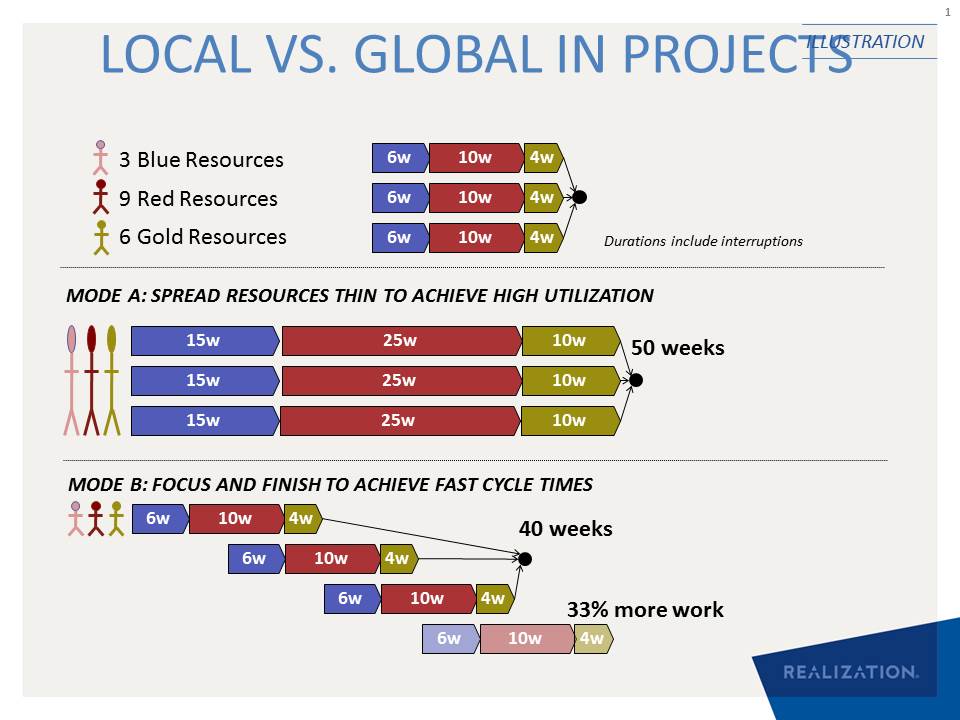Sanjeev Gupta: CCPM – Project Factory, 3 Webinars

Webinar 1: Focus & Finish: Operating Motto for a Project Factory
The pdf of the material used in Webinar 1
Webinar 2: Role of Buffers in CCPM
The pdf of the material used in Webinar 2
Webinar 3 “Project Planning for the Real World – A Tutorial”
The pdf of the material used in Webinar 3
Sanjeev’s post on Linkedin 10 Feb 2018:
YOUR PROJECTS HAVE A SCHEDULING PROBLEM IF:
1. You have tried creating a single source of truth but people prefer their own “back pocket” schedules
2. You have frequent meetings to resolve schedule/resource conflicts
3. Everyone is constantly firefighting and waiting on someone else
4. People are perpetually overloaded
5. High priority projects get done in half the time – which only means that with correct scheduling, all projects can get done much faster.
If you have a SCHEDULING PROBLEM, improving processes or soft skills WON’T improve project delivery or resource efficiencies. ONLY fixing the scheduling problem will.
PLEASE FIX THE SCHEDULING PROBLEM.
Feedback and discussion after Webinar 1
Even beyond Projects, I believe this is highly relevant to other digital knowledge-work environments as well – including IT Service Factories where the absence of physical material (to materialize queues and work-in-process) and a prevalent lack of manufacturing background, makes most people overlook the need for Manufacturing Wisdom in order to manage what I would call their “Invisible Plant”. Especially when it comes to segmenting activities according to their relevant manufacturing layout (eg. Intermittent vs. Fixed). I am proudly going to print out this “Focus and Finish” motto with due credit, and display it prominently at my workplace – including in my corporate email signature
. Thank you Sanjeev and hats off TOCPA for sharing such gems of a kind.
Paul Merino
An additional issue is that as project time extends, the number of changes (e.g. red time on project is 25 weeks instead of 10 weeks) and queries and client requests for status updates and the management and resource time is consumed. Is the point that when doing buffer management not to switch priorities based on small differences between relative buffers on subtasks. It would be an example of trying to be more accurate than the noise. Thanks very much. Very helpful.
Colin Beattie
It was a great session.
Robert Bolton
Just caught the recording. Great presentation Sanjeev. Very clear and thought provoking.
Ian Heptinstall
Just watched Sanjeev. Great stuff! Thanks for giving him a stage. Good to see that he sees the same issues with CCPM and comes up with very similar solutions to us. The Operating Motto stuff is interesting. I see it as the synthesis between the behavior needed for the system as a whole and the behavior that satisfies the local need/desire (such as being ‘productive’ in Sanjeev’s example).
Hans Steenpoorte
A question from Doug Krsek:
How would an organization/department/group manage work across both project and operational support tasks like in an IT group?
Sanjeev’s answer:
Two things are important
- WIP Control (total planned WIP of project and operational tasks should be less than the capacity). Since the operational tasks are not known as far in advance of project tasks, you leave aside some capacity for operational tasks when you stagger the projects.
- Task Priorities across project and operational tasks.
A question form Uwe Techt:
If I understood Eli right, he said, that staggering based on resources will show too much variability. Because of that he called for staggering on phases. Is there a contradicting with your argumentation?
Sanjeev’s answer:
Yes, staggering based on resources/tasks will show too much variability. However a more important issue is that it will cause tasks to spread apart and resources to get spread thin.
Here is Sanjeev’s explanation why the middle graph shows the tasks duration multiplied not by 3, but less:
When all resources are allocated to one project, resource utilization is lower (not all of the resources will be busy all the time because of dependencies etc.). When fewer resources are allocated to one project, they are more fully utilized and that’s why the duration does not increase by 3X but less.
Feedback and discussion after Webinar 2
Another EXCELLENT workshop, Sanjeev.
Charlene Spoede Budd
You say that the timeline is determined by the client. This does not avoid the problem of buy in with your resources. If it is decided by management edict and they feel it is too short would they not be demotivated by this? [Answered by Sanjeev in the webinar.] Excellent session Sanjeev.
Mike Dinham
Returning to ‘The market sets the duration’. A senior executive will want to know whether his organisation is taking too much risk or not. If duration and buffers are set only by ‘market demand’, how can they judge whether they are taking too much risk by accepting a crazy due date. Surely there is a need for a zero-based approach to planning? [Answered by Sanjeev in the webinar.]
Ian Heptinstall
Project Buffer goal then it is not to reducing the Project due date, and maybe achieving a competitive advantage, but rather it is to add required flexibility to be able to comply with any committed Due date, and be reliable on it? A Competitive Edge may come firstly from reliability of Due Date, rather than reduced lead time? [Answered by Sanjeev in the webinar.]
Jorge Ramirez
Market usually provides less time than is necessary (owners/ operators approach EPC’s late from the beginning…). PM’s are given ISD that ate unreasonable (granted with traditional task level buffers!) Any recommendations for dealing with resources pay rates (time sheets vs. fixed rate), resource managers incentive? [Answered by Sanjeev in the webinar.]
Luis Cabana
